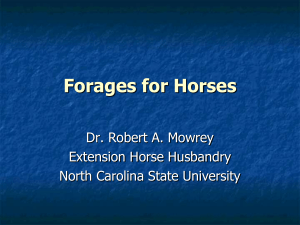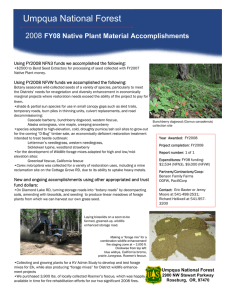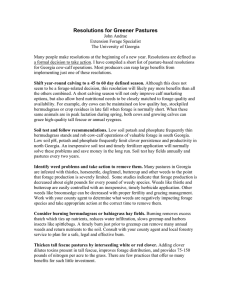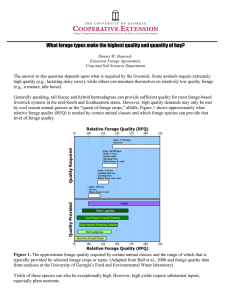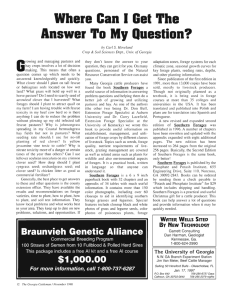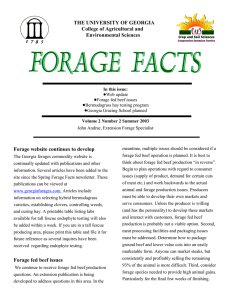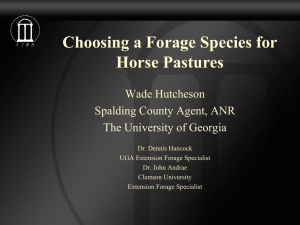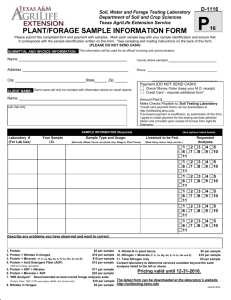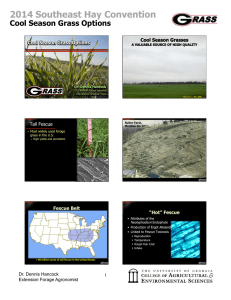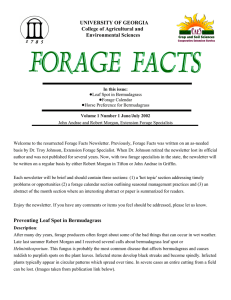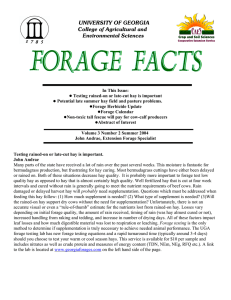UNIVERSITY OF GEORGIA College of Agricultural and Environmental Sciences
advertisement
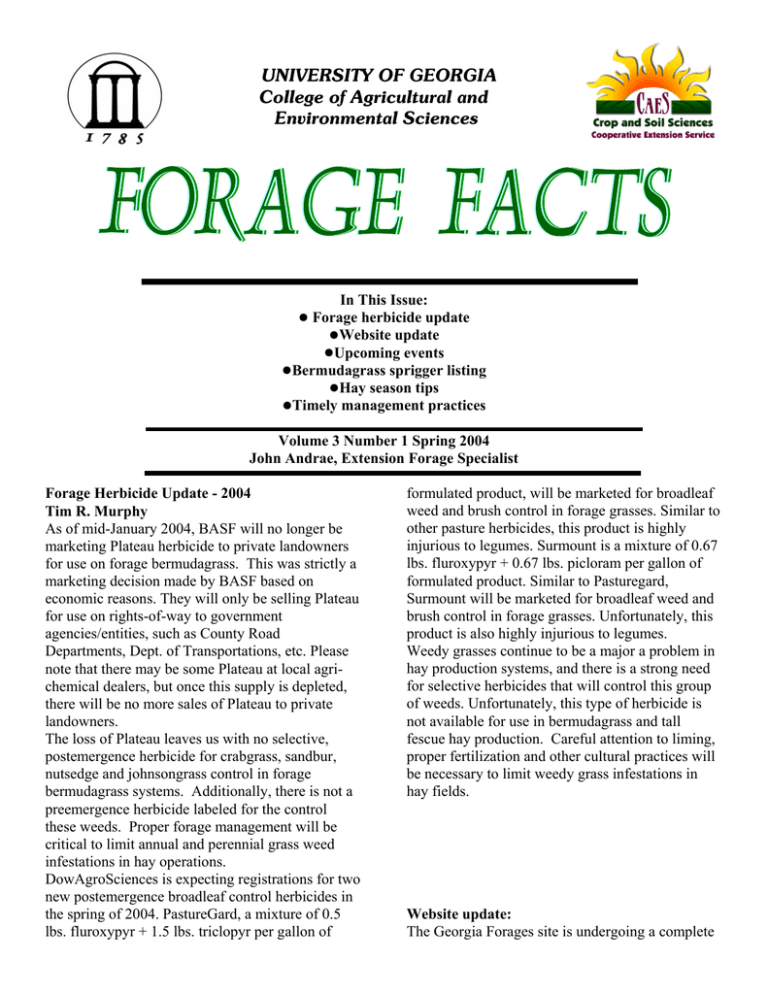
UNIVERSITY OF GEORGIA College of Agricultural and Environmental Sciences In This Issue: ! Forage herbicide update !Website update !Upcoming events !Bermudagrass sprigger listing !Hay season tips !Timely management practices Volume 3 Number 1 Spring 2004 John Andrae, Extension Forage Specialist Forage Herbicide Update - 2004 Tim R. Murphy As of mid-January 2004, BASF will no longer be marketing Plateau herbicide to private landowners for use on forage bermudagrass. This was strictly a marketing decision made by BASF based on economic reasons. They will only be selling Plateau for use on rights-of-way to government agencies/entities, such as County Road Departments, Dept. of Transportations, etc. Please note that there may be some Plateau at local agrichemical dealers, but once this supply is depleted, there will be no more sales of Plateau to private landowners. The loss of Plateau leaves us with no selective, postemergence herbicide for crabgrass, sandbur, nutsedge and johnsongrass control in forage bermudagrass systems. Additionally, there is not a preemergence herbicide labeled for the control these weeds. Proper forage management will be critical to limit annual and perennial grass weed infestations in hay operations. DowAgroSciences is expecting registrations for two new postemergence broadleaf control herbicides in the spring of 2004. PastureGard, a mixture of 0.5 lbs. fluroxypyr + 1.5 lbs. triclopyr per gallon of formulated product, will be marketed for broadleaf weed and brush control in forage grasses. Similar to other pasture herbicides, this product is highly injurious to legumes. Surmount is a mixture of 0.67 lbs. fluroxypyr + 0.67 lbs. picloram per gallon of formulated product. Similar to Pasturegard, Surmount will be marketed for broadleaf weed and brush control in forage grasses. Unfortunately, this product is also highly injurious to legumes. Weedy grasses continue to be a major a problem in hay production systems, and there is a strong need for selective herbicides that will control this group of weeds. Unfortunately, this type of herbicide is not available for use in bermudagrass and tall fescue hay production. Careful attention to liming, proper fertilization and other cultural practices will be necessary to limit weedy grass infestations in hay fields. Website update: The Georgia Forages site is undergoing a complete overhaul. A new and improved site will soon be posted at www.georgiaforages.com. After the new site is posted, please check the newly added “Frequently Asked Questions” section for questions that specialists and county agents tend to receive often. Also note the addition of a “County Agents Only” section to deliver scripted PowerPoint presentations for county-level delivery. These presentations will be posted within a couple of weeks. Upcoming field days and trainings: A two-day South Georgia Grazing School is scheduled for April 5th and 6th at the Rural Development Center in Tifton. A similar school was held last fall in Athens. Due to multiple requests, we will conduct a program developed specifically for South Georgia forage producers. A complete agenda for this program can be found at www.georgiaforages.com. Attendance at this school will be limited to 35 producers, so please reserve your spot today. The Mountain Research and Education Center near Blairsville with host its annual Mountain Beef Cattle Field Day on April 21st. Grass tetany, heifer development, beef alliances, U.S. animal ID plan, stocker research updates, forage updates and ultrasound demonstrations are on the agenda. For more information on this field day, contact your local county agent or Mr. Joe Garner at 706-7452655. A forage field day is scheduled for April 27th in Ranbourne AL (just across the state line from Bowdon GA). The field day will begin at 4 PM CENTRAL time. For more information contact Chip East, County Extension Agent in Clebourne County AL. A forage field day will be held on April 29th at the Central Georgia Research and Education Center located near Eatonton. Recent tall fescue and white clover releases as well as updates on weed and grazing management will be discussed and demonstrated. A detailed agenda is in the final development stage. For more information on this program, contact your local county agent. Lunch will be provided by Pennington Seeds. Please RSVP with your local agent for planning purposes. Agents, please contact Keith Fielder with expected attendance for meal planning. A forage field day is scheduled for May 4th at 4 PM in Gilmer County Georgia. New clover varieties, tall fescue varieties, and methods for converting toxic tall fescue will be discussed. For more information contact Michael Wheeler, County Extension Agent in Ellijay. A forage field day is scheduled for May 11th near Calhoun. A day long program and field day will be held at the Red Bud Research and Demonstration Farm. Morning presentations will address current research, as well as the potential and limitations of producing forage-fed beef. Afternoon tours of research plots will highlight clover, tall fescue, and bermudagrass forage research; utilization of byproducts for fertilizers; and water quality projects. For more information contact your local county agent or see the Georgia Forages website. Bermudagrass spriggers listing: A listing of Georgia bermudagrass spriggers has been assembled and posted at the Georgia Forages website (www.georgiaforages.com). I appreciate all the county agents who submitted sprigger information and will be happy to update the guide with any spriggers not currently listed. I hope you find the list helpful. Hay season tips: With spring harvest of tall fescue and ryegrass approaching, it is important to review factors for harvesting high quality hay. The most important factor determining hay quality remains timely harvesting. Even though this is an extremely simple factor, most producers continue to harvest their hay when it is too mature. Even though delayed cuttings yield more bales, the poor quality of these bales increases supplementation needs and/or decreases animal performance. It is generally true that tall fescue hay harvested at the proper maturity has a greater risk of rain damage than tall fescue hay cut in June or early July. There are two options for baling tall fescue hay. Option one: cut in May at boot stage or early flowering and stand a chance of conserving high quality forage. Option two: delay harvest until later in the year and GUARANTEE a low quality cutting (even if it doesn’t rain on the hay in June and July). An added benefit of timely cutting is that tall fescue has an opportunity to recover after cutting. With favorable summer weather, a high quality second cut can be harvested. Moisture of forage in the windrow should be a maximum of 20% and ideally should be below 18% to prevent mold formation and heating in bales. If hay is rolled at a high moisture content, the forage can heat and spontaneously combust. Bale temperatures peak around 2 weeks following packaging and decline slowly to safe levels. Heat damage of bales occurs when temperatures exceed 130 degrees and fire danger occurs when temperatures exceed 170 degrees. If it is suspected that hay was baled too wet, closely monitor temperatures of bale centers before storing in barns. Remember that bale temperatures will not peak for at least two weeks after rolling. Timely management practices: Questions received in spring months typically revolve around timing of management practices. We are often asked the question “Is it too late to ________”. The following is a listing of several common time-oriented questions received during spring months. How late can bermudagrass be burned? Bermudagrass can be burned until just after greenup with little risk of damage. Burning bermudagrass can hasten greenup, remove winter annual weeds, decrease spittlebug pressure, and release nutrients from the thatch layer. Ideally, there should be around 6” of residue for a good burn. Too little residue and the fire will not carry well. Too much residue and bermudagrass stolons can be damaged and the fire can be difficult to control. As always, consult with your local forestry service for safety information and weather information before you begin the burn. Is it too late to plant ryegrass? Ryegrass planted in March will produce little forage until early to mid April. If spring months are hot and dry little or no benefit will be realized from these late plantings. Plan ahead next year and plant in the fall months for good small grain and ryegrass production. Is it too late to overseed white or red clover? It is too late to establish these varieties in warm season forages, but it may be possible to establish perennial clovers in tall fescue until mid-March. Drilling these clovers in late fall or broadcasting in January or February is a far more dependable practice. Is it too early to sprig bermudagrass? No, early spring is the ideal time to establish bermudagrass from sprigs. Bermudagrass has not broken dormancy and energy reserves in sprigs are high in February and March.

